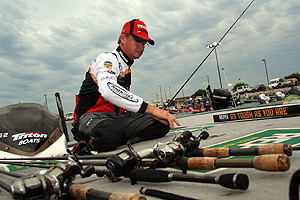
Choosing a fishing line isn't as easy as it used to be. Early in my career, there were two main choices - Berkley monofilament and Stren monofilament. Today there are dozens of options.
Anglers now have multiple choices in line materials, performance characteristics and even color. It gets confusing for old-timers like me, so I can only imagine how it must be for anglers just getting started.
The most important aspect that anglers need to understand about the various lines is how their properties affect their fishing. Although a premium monofilament will serve you well regardless of the technique or fishing style, some specialty lines will provide better results when used in specific situations.
Stretch, durability, diameter, visibility and sink rate are all important considerations. Those factors not only influence casting distance and hooking/playing the fish, but they also play a role in lure appeal and performance.
While braided line has been around forever, the new generations are much easier to use. Braid gives you substantially more strength and limpness in less diameter, therefore providing a line that handles like soft mono but with the strength of rope.
The better braids also are round in shape, whereas earlier designs were flat, creating spooling problems and impossible backlashes. A round line manages and casts much better.
The drawbacks are that braid has little or no stretch. Thus, it is possible to literally rip a hook through a fish's mouth or even break the rod on a hookset, especially if you're using it on the same action of rod used for fishing mono. For that reason, I tend to prefer softer action rods for braid. In situations where I use a heavy action for mono, I'll drop to a medium or medium heavy for braid.
However, that lack of stretch can be an asset, such as when you're making long casts, fishing grass or pitching deep into the lily pads. Anytime you set the hook at the end of a long cast with mono, the rod has to remove the stretch before the hook penetrates the fish's mouth. Braid sets the hook lightning quick and will cut through vegetation better than any other line.
Braided line is also opaque, so it is more visible in clear water. That bugs me, so I add a leader to the business end for a more natural lure presentation.
Fluorocarbon is another alternative to monofilament that more anglers are using. The latest of the new lines looks like mono but is made of an entirely different material. Fluorocarbon is said to refract light. Therefore, it is virtually invisible beneath the surface, making it a good choice for finessing fish in clear water.
Other benefits include toughness and sensitivity. The line has less stretch than mono but more than braid, offering a fair compromise. However, it tends to be a little stiffer than most monos, although manufacturers are doing a better job of making fluorocarbon lines more manageable.
Perhaps the most noticeable difference is it sinks, whereas mono and braid tend to lie on the surface better. Also, fluorocarbon is ideal for fishing stick worms like Senkos because it allows these baits to flutter better on the fall. However, it's not a good choice for topwaters designed to "walk" or "spit" across the surface.
It's important to note that there isn't one brand or material of line that gives anglers the very best of all these characteristics. Nor is 12-pound line of brand X identical to 12-pound of brand Z. Before trying a line, question anglers in your area about what works best for them and why.
You can find more articles, quick tips and much more at HankParker.com.




